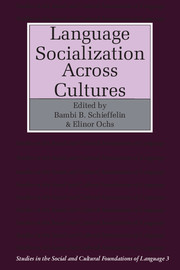Book contents
- Frontmatter
- Contents
- List of contributors
- 1 Introduction
- Part I Acquiring language and culture through interactional routines
- 2 Calling-out and repeating routines in Kwara'ae children's language socialization
- 3 Prompting routines in the language socialization of Basotho children
- 4 Interactional routines as cultural influences upon language acquisition
- 5 What no bedtime story means: narrative skills at home and school
- Part II Acquiring knowledge of status and role through language use
- Part III Expressing affect: input and acquisition
- Index
3 - Prompting routines in the language socialization of Basotho children
Published online by Cambridge University Press: 05 June 2012
- Frontmatter
- Contents
- List of contributors
- 1 Introduction
- Part I Acquiring language and culture through interactional routines
- 2 Calling-out and repeating routines in Kwara'ae children's language socialization
- 3 Prompting routines in the language socialization of Basotho children
- 4 Interactional routines as cultural influences upon language acquisition
- 5 What no bedtime story means: narrative skills at home and school
- Part II Acquiring knowledge of status and role through language use
- Part III Expressing affect: input and acquisition
- Index
Summary
The learning of socially appropriate norms of behavior is a complex and multifaceted process. Prompting for the use of appropriate verbal behavior plays an active role in the social development of children in Basotho society. This chapter examines the prominent use of ere … ‘say …’ and other prompts by Sesotho-speaking caregivers during interaction with children. It identifies the forms these linguistic routines take and the functional contexts in which they occur. Finally, it examines how these prompts are used in the socialization of young children, providing them with a framework from which to recognize social situations and respond accordingly.
Background
Lesotho is a small, dry, mountainous country completely surrounded by the Republic of South Africa. Sesotho, or Southern Sotho, is a southern Bantu language used by approximately three million speakers, half of whom reside in Lesotho, the other half resident in South Africa. The people who live in Lesotho and speak Sesotho call themselves Basotho. Many Basotho men have been employed in the mines in South Africa since the mid 1800s. Fosterage, whereby children are sent to live with grandparents, aunts, or uncles, has long been practiced and is still common in both rural and urban areas. Rural women have traditionally worked in the fields, leaving children to entertain themselves, or, in the case of infants, leaving them with grandmother or neighbors.
- Type
- Chapter
- Information
- Language Socialization across Cultures , pp. 51 - 79Publisher: Cambridge University PressPrint publication year: 1987
- 4
- Cited by



